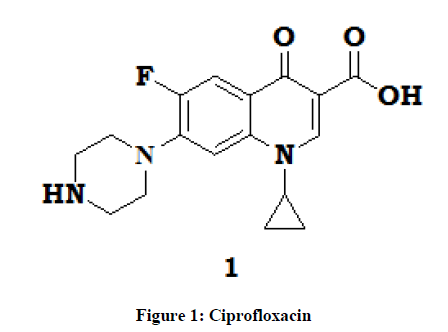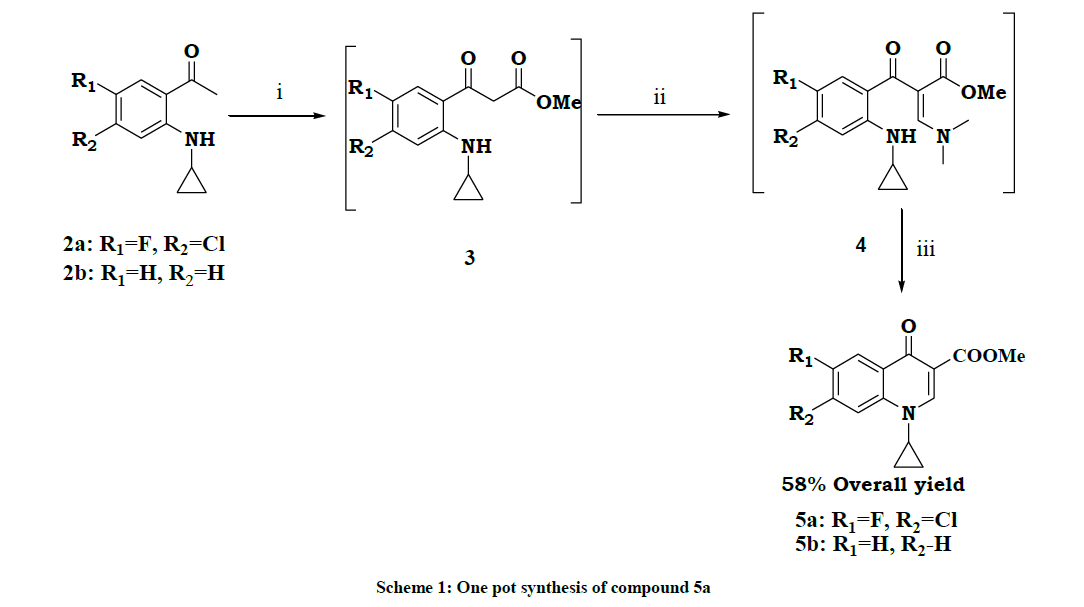Research Article - Der Pharma Chemica ( 2018) Volume 10, Issue 9
A New Process for Ciprofloxacin HCl
Sreenivasula Reddy bandatmakuru and Veera Reddy Arava*
R and D centre Suven Life Sciences Ltd, Plot No #18, Phase-III, Jeedimetla, Hyderabad-500055, India
- *Corresponding Author:
- Veera Reddy Arava
R and D centre Suven Life Sciences Ltd
Plot No #18, Phase-III, Jeedimetla, Hyderabad-500055, India
Abstract
A single step process for the synthesis of quinoline-3-carboxylic acid was developed from 2’-amino acetophenons. With this method a Key intermediate of ciprofloxacin is prepared.
Keywords
1-(4-Chloro-2-cyclopropylamino-5-fluoro-phenyl)-ethanone, Dimethyl carbonate, DMF-DMS Complex.
Introduction
Ciprofloxacin (1) (Figure 1) is a broad based antibiotic of the fluoroquinoline class. It is active against both gram-positive and gram-negative bacteria. It functions by inhibiting DNA gyrase and a type-II and type-IV topoisomerases necessary to separate bacterial DNA, there by inhibiting cell division. Ciprofloxacin is on the World Health Organization List of Essential Medicines [1]. Bayer AG developed and patented a seven-step synthesis [2] in the 1980’s with an overall yield of 49% and Later, a similar sequence of reactions [3] were performed, but slightly increasing the overall yield to 57%.
Materials and Methods
Most of the reagents used in this work were obtained from commercial suppliers and were of LR/AR grade. Solvents were purified before use by standard procedures. Melting points were determined using open capillary tubes on POLMON melting points apparatus (Model-96) and are uncorrected. 1H (400 MHz) and 13C (100 MHz) NMR spectra were recorded by using a Bruker 400 Spectrometer with Tetramethylsilane (TMS) as internal standard. IR spectra were recorded on a Perkin-Elmer Spectrum 100 FTIR Spectrophotometer as KBr pellets or with the neat products. Mass spectra were recorded on an API 2000 LCMS/MS Applied Bio Systems MDS Sciex spectrometer. Analytical TLC was conducted on E-Merck 60F254 aluminium-packed plates of silica gel (0.2 mm). Developed plates were visualized by using UV light or in an iodine chamber. High Performance Liquid Chromatograpy (HPLC) was performed by using a Shimadzu 2010 instrument.
Synthesis of 7-Chloro-1-cyclopropyl-6-fluoro-4-oxo-1,4-dihydro-quinoline-3-carboxylic acid methyl ester (5a)
To a solution of Sodium hydride (0.70 g, 4.0 mol) and THF (30 ml) Dimethyl carbonate (1.58 g, 4.0 mol ) was added at 20°C-25°C for 5-6 min, temperature raised to 60°C-65°C and stirred for 20 min. After 20 min was added a solution of 1-(4-Chloro-2-cyclopropylamino-5-fluoro-phenyl)-ethanone (1.0 g, 1.0 mol) in THF (200 ml) at 60°C-65°C for 10 min and stirred for 3 h at 60°C-65°C. After completion of reaction (monitored by TLC), reaction mixture was cooled to 0°C-5°C and DMF-DMS Complex (3.5 g, 4.0 mol) was added to the reaction mixture at 0°C-5°C for 5 min. The mixture was stirred at 0°C-5°C for 1 h. After completion of the reaction (monitored by TLC), temperature rose to 50°C- 55°C and stirred at 50°C-55°C for 4 h. After completion of the reaction (monitored by TLC), reaction mass was cooled to 25°C-30°C and quenched into ice water (50 ml), extracted with dichloro methane (2 × 20 ml). The combined organic extracts were washed with water (20 ml), and dried over sodium sulfate, filtered, and concentrated under reduced pressure to get 1 g of crude product. The crude product was recrystallization in ethyl acetate to get 5a (0.70 g), Yield 58%. Product 5a was confirmed on the basis of spectral data. Description: off white color solid; M.p.: 240.2-243.3°C; IR (KBr) (cm-1): 3436, 2952, 1701, 1731, 1613, 1639, 1478, 1196, 803; 1H-NMR (CDCl3, 400 MHz): δ (ppm)=8.61 (s, 1H), 8.23 (d, J=8.9 Hz, 1H), 8.0 (d, J=5.8 Hz, 1H), 3.9 (s, 3H), 3.48-3.44 (m, 1H), 1.41-1.36 (q, 2H), 1.18-1.14 (q, 2H); 13C-NMR (CDCl3, 100 MHz): δ (ppm)=172.72, 165.89, 156.98, 154.49, 149.0, 137.17, 128.74, 128.68, 126.94, 118.95, 114.0, 113.82, 110.50, 525.24, 34.79, 8.28. Mass for C14H11ClFNO3 [M+1], found 297.7.
1-Cyclopropyl-4-oxo-1,4-dihydro-quinoline-3-carboxylic acid methyl ester (5b)
Yield 54%; Product 5b was confirmed on the basis of spectral data. Description: White color solid; M.p.: 236.7-238.1 =°C; IR (KBr) (cm-1): 3100, 3013, 2945, 1729, 1624, 1607, 1481, 1351, 1243, 1215, 1093, 1045, 772; 1H-NMR (CDCl3, 400 MHz): δ (ppm)=8.53 (s, 1H), 8.23 (d, J=8.05 Hz, 1H), 8.09 (d, J=8.45 Hz, 1H), 7.85-7.81 (t, J=7.2 Hz 1H), 7.53-7.49 (t, J=7.51, 1H), 3.75 (s, 3H), 3.68-3.65 (m, 1H), 1.28-1.23 (q, 2H), 1.11-1.07 (q, 2H);13C-NMR (CDCl3, 100 MHz): δ (ppm)=173.35, 165.49, 149.11, 140.92, 133.11, 128.17, 126.61, 125.53, 118.03, 110.01, 51.76, 35.17, 8.04. Mass for C14H13NO3 [M+1], found 243.5.
Result and Discussion
According to literature [2-16] there are many synthetic routes available for the synthesis of ciprofloxacin. In this paper we wish to report yet another route for the synthesis of ciprofloxacin with different starting material 2. 1-(4-Chloro-2-cyclopropylamino-5-fluoro-phenyl)-ethanone [11] 2 was reacted with dimethyl carbonate in presence of sodium hydride to give beta keto ester 3, which was further reacted with DMF-DMS Complex to get 4, and finally heated the compound 4 to get key intermediate 5a, with an overall yields of 58%. From 5a in one step the drug can be synthesized. The whole process is described in Scheme 1.
i) Dimethyl carbonate, NaH, THF, 60°C-65°C, 3 h; ii) DMF-DMS Complex, 0°C-5°C, 1 h; iii) 50°C-55°C, 3 h.
Conclusion
We developed a simple method for the preparation of Quinoline-3-carboxylic acids.
Acknowledgement
We would like to thank Suven life sciences for providing excellent analytical facilities and our CEO Mr Jasti for allowing us to publish this work.
References
- http://www.who.int/medicines/publications/essentialmedicines/EML2015_8-May-15.pdf.
- J.J. Li, D.S. Johnson, D.R. Sliskovic, B.D. Roth, Contemporary Drug Synthesis, Wiley, Hoboken, 2004, 75-87.
- a) A.A. MacDonald, S.H. DeWitt, E.M. Hogan, R. Ramage, Tetrahedron Lett., 1996, 37, 4815-4818.
b) A.M. Hay, S. Hobbs- Dewitt, A.A. MacDonald, R. Ramage, Tetrahedron Lett., 1998, 39, 8721-8724.
c) A.M. Hay, S. Hobbs-Dewitt, A.A. MacDonald, R. Ramage, Synthesis., 1999, 1979-1985. - a) K. Grohe, H. Heitger, Libig Ann. Chem., 1987, 29-37.
b) A.G. Bayer, US 5, 639, 886A, 1997/EP 0657448A1. - Zerbes, R.; Naab, P.; Frankowiak, G.; Diehl. H.; US 5,639,886A, 1997.
- K. Grohe, H.J. Zeiler, K. Metzger, DE 3142854, 1983.
- K. Grohe, H.J. Zeiler, K. Metzger, US 4670444, 1987.
- A. Veerareddy, M. Pullareddy, Indian patent, 1999.
- P.R. Muddasani, V.C. Nannapaneni, WO 2001085692A2, 2001.
- D.R. Rao, P. Ravi, B. Sunil, A.P. Kumat, M. Sunil, WO 2012127505, 2012.
- V.R. Arava, S.R. Bandatmakuru, Synthesis., 2013, 45, 1039-1044.
- R.G. Gould, W.A. Jacobs, J. Am. Chem. Soc., 1939, 61(10), 2890-2895.
A. Kirshning, Beilstein. J. Org. Chem., 2009, 5, 15 A. Kirshning, Beilstein. J. Org. Chem., 2011, 7, 1046-1047. - T. Schwallbe, D. Kadiziminsz, G. Jas, QSAR Combi. Sci., 2005, 24, 758-768
- H. Lin, C. Dai, T.F. Jamison, K.F. Jensen, Angew. Chem. Int. Ed., 2017, 56, 8870-8873.
- V.R. Arava, P. Umareddy, Pharma. chem., 2018, 10(3), 174-178.





